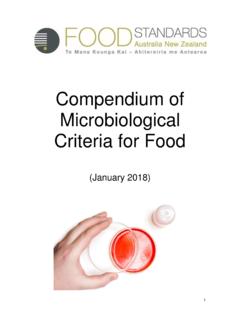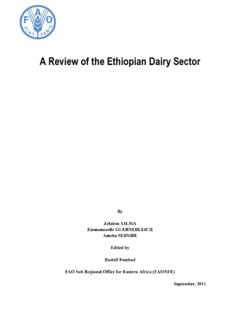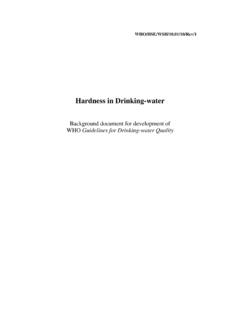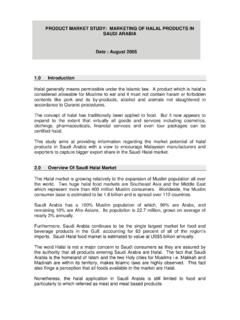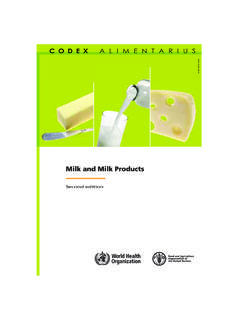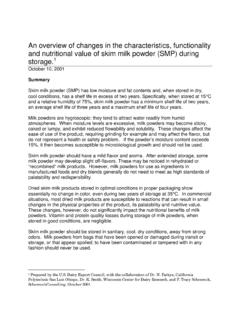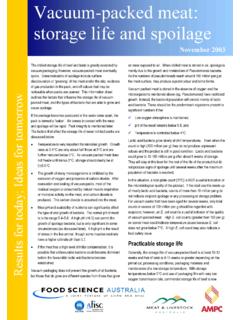Transcription of Peroxyacetic acid rinses on poultry meat: the …
1 Peroxyacetic acid rinses on poultry meat: the consumer perspective BEUC Position Paper Contact: Camille Perrin Ref.: BEUC-X-2014-052 - 07/07/2014. BUREAU EUROP EN DES UNIONS DE CONSOMMATEURS AISBL | DER EUROP ISCHE VERBRAUCHERVERBAND. Rue d'Arlon 80, B-1040 Brussels Tel. +32 (0)2 743 15 90 Fax +32 (0)2 740 28 02 EC register for interest representatives: identification number 9505781573-45. Summary Foodborne pathogens are a significant public health problem. poultry , in particular, is frequently incriminated in diseases caused by food poisoning bacteria Salmonella and Campylobacter. As these pathogens can spread to humans by handling, preparing or consuming contaminated poultry meat but also as a result of direct contact with infected live chickens, their successful control requires an integrated approach from the farm to the fork as is currently in place in the EU.
2 Whilst it could be further improved, overall this approach has helped achieve a high level of food safety in the EU. By contrast, in the US, interventions to control meat-borne pathogens largely take place at the abattoir level. Wide use is being made of chemical decontamination treatments such as chlorine or peroxyacids solutions at different steps in the slaughter line. Following an application from the US, the EU is set to consider whether to authorise Peroxyacetic acid (PAA) solutions for use on poultry carcases and meat. EFSA, whose opinion was sought on the safety and efficacy of PAA, did not identify any major toxicity concerns but noted uncertainties on the safety of HEDP, a component of PAA solutions.
3 Moreover, risk of antimicrobial resistance as a result of PAA use could not be fully excluded. As for occupational health risks, they were not considered by EFSA, although PAA is a known skin, eye and lung irritant. Evidence of PAA efficacy was equally not conclusive in that it either mostly rested on effects on non-pathogenic bacteria and/or on low to medium strength of evidence studies. BEUC is concerned that PAA washes will not deliver any extra safety net . Rather, we see the risk they might be seen as a convenient substitute for good slaughter hygiene. The availability of such treatment be it of little efficacy . might lead slaughterhouse staff to be less vigilant on preventing carcass contamination to happen in the first place, hence putting consumers' health at risk.
4 In our opinion, efforts should focus on preventing and controlling contamination with food poisoning bacteria at the earliest possible stage in the food chain (biosecurity measures, control of feed and drinking water quality, etc.) as it is expected to deliver the greatest public health benefits. If decontamination treatments are at all to be considered, their safety and efficacy shall be unequivocally established. Moreover, their use shall never substitute for good husbandry and hygiene practices on farm and at the abattoir. It is also vital to hear European consumers' preference for meat that has not undergone any kind of chemical treatment, meaning that the use of such treatments, if at all permitted, should be transparent for consumers through labelling.
5 Finally, the EU decision on whether or not to allow PAA or any other meat treatment should be made in the best interest of food safety and consumer protection, and not under pressure from trade partners. 2. I. Introduction Foodborne zoonotic illnesses are caused by consuming food or drinking water contaminated by disease-causing micro-organisms, for instance bacteria such as Salmonella or Campylobacter. They are a major global public health threat and, in the EU, they affect over 320,000 people each year. A variety of foods ( dairy products, fruits and vegetables) can convey these diseases but meat and meat products are particularly at risk.
6 Indeed many of the pathogenic micro-organisms causing these diseases are commonly found in the intestines of In the EU, the healthy food-producing animals. To efficiently protect farm to fork'. consumers, the EU has adopted an integrated approach approach aims to to food safety from the farm to the fork , whereby ensure meat preventive actions, good hygiene and controls must be safety at all applied throughout the food chain to minimise risks of production stages. contamination and ultimately ensure consumers can enjoy safe food. When it comes to meat, this translates as on-farm biosecurity measures, good husbandry practices, interventions at animal transport level as well as good slaughter hygiene.
7 Some of EU's trade partners have opted for a different In the US, approach. In the US, for instance, there are no legal chemical requirements for farm-level control measures that would decontamination help reduce Salmonella contamination in chickens before of meat in the they arrive at slaughter facilities1, whilst, at the abattoir abattoir is the level, the use of chemical decontamination treatments of common meat is common practice. It was only very recently and practice. after an official US request that EU legislation allowed the use of lactic acid to decontaminate beef carcases 2, whilst only water3 had been previously accepted to remove surface contamination from products of animal origin, under certain conditions.
8 Other treatments, including peroxyacids and chlorine for poultry , have not been approved in the EU to date due to insufficient evidence of their efficacy and/or due to a lack of conclusive evidence allowing to exclude the risk of antimicrobial resistance as a result of their use4,5. 1. The Pew Charitable Trusts. Weaknesses in FSIS's Salmonella Regulation: How two recent outbreaks illustrate a failure to protect public health. December 2013. 2. EU Regulation (EU) No 101/2013 concerning the use of lactic acid to reduce microbiological surface contamination on bovine carcases. 3. See Art. 3(2) of Regulation (EC) No 853/2004 laying down specific hygiene rules for food of animal origin.
9 4. SCHER and SCENIHR (2008). Opinions on the Environmental impact and effect on antimicrobial resistance of four substances used for the removal of microbial surface contamination of poultry carcases . 5. EFSA (2008). Opinion of the Scientific Panel on Biological Hazards on the Assessment of the possible effect of the four antimicrobial treatment substances on the emergence of antimicrobial resistance. 3. In May 2013, the US Department of Agriculture (USDA) re-submitted an authorisation request for the use of Peroxyacetic acid (hereafter PAA), one of the most commonly used peroxyacids on poultry carcases and meat. The EFSA Opinion6. assessing the safety and efficacy of PAA was released on 26 March 2014.
10 Based on the advice from EFSA, EU risk managers are now set to decide whether or not to permit the use of PAA solutions as a decontamination treatment of poultry carcases and meat. BEUC firmly supports the EU's farm to fork approach. As a general stance, as long as good hygienic practices are If good hygiene complied with and Hazard Analysis and Critical Control Point practices are (HACCP)7 systems are well managed by food business applied across operators - as required by EU law we believe there should the chain, end- be no need for additional treatments of meat. Rather, we of-pipe are concerned such treatments may result in a lowering of treatments are EU hygiene standards as less scrupulous operators might not needed.



